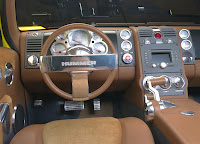Hummer H2 SUT Dirt Sport Concept, 2003



The H2 is the second vehicle sold under the Hummer marque of General Motors. It is a large SUV (though smaller than the Hummer H1) with room for five passengers and substantial off-road ability. The rearmost part of the H2 SUV was modified to a pickup truck bed for the 2004 H2 SUT ("Sport Utility Truck").
Overview
The H2 is built under contract by AM General at a specially constructed plant in Mishawaka, Indiana, USA. Although it shares GM's GMT820 truck platform with the Chevrolet Tahoe and GMC Yukon, those vehicles differ in many ways and are constructed in three other GM plants. The H2's final frame assembly is made up of 3 sections: The front uses a modified GM 2500-Series utility frame, the mid-section is all new and is completely boxed, and the rear section uses a modifed GM 1500-Series frame which is upgraded for the 8000 pound (3629 kg) gross vehicle weight.
H2 sales were initially strong, but fell to 28,898 for 2004 and 23,213 for 2005.
The H2 was nominated for the North American Truck of the Year award for 2003.
Engine
2003–2005 6000 6.0 L (366 in³) V8
Capabilities
With its high ground clearance, large tires, protective underbody plates, and low gearing, the H2 is capable of climbing over a 20-inch-high (0.4 m) step-up wall. A massive truck frame and wide track offer stability against overturning compared to some of the more common light truck SUVs, although objective tests have not been performed by the government or other outside parties due to its specialised vehicle class.
Fuel economy
For typical travel on improved roads, users report fuel economy of between 10 and 14 miles per gallon, which converts to between 14 and 17 L/100 km. Worst case urban driving is said to be in the range of 8 to 14 U.S. mpg (21 to 25 L/100 km). Although General Motors does not provide official H2 fuel economy ratings, most reviews have observed high single to low double-digit mileage, similar to the numbers above.
It should be noted that other large vehicles also have poor fuel economy especially with optional larger engines including the Dodge Ram 1500 series pickup trucks equipped with either the 8.3L V10 (MSRP US$48,500) or the 4.7L V8 Flexible Fuel engine running E85 fuel (MSRP US$31,300). Both of these engines are rated at 9 U.S. mpg city and 11 U.S. mpg highway by the E.P.A. as one example.
Tax benefits
Under the United States income tax code, the cost of vehicles over 6,000 pounds (2722 kg) can be deducted from income. This deduction was enacted decades ago to assist self-employed people in purchasing a vehicle for business use. The weight minimum was intended to limit the deduction to commercial-type trucks. For many years, the deduction remained below the average cost of a new vehicle, since large trucks were relatively inexpensive. Since it is a reduction in taxable income, the actual value of this deduction averages 30% of the price of the vehicle in question.
The increasing popularity of these vehicles in the last decade, however, pushed their average price to nearly double the average passenger car cost. In response, the 2002 Tax Act increased this "Section 179 depreciation deduction" to US$75,000, and it rose again to US$102,000 for the 2004 tax year. This is more than three times the current average cost of a passenger car in the United States and covers a large number of luxury models, including the Hummer H2. In late 2004, the deduction was again reduced to US$25,000.
Criticism
The Hummer H2 is one of the most severely criticized civilian vehicles on the market today. Critics have expressed concern at the fuel economy which they cite as being among the most inefficient of vehicles. The Environmental Protection Agency does not test them for fuel economy because of their weight, they are thus categorised as light trucks and thus are not bound to fuel economy standards.
The Hummer H2 is criticised for contributing towards petroleum comsumption in the United States. In addition, they are criticized for obstructing the views of drivers behind them with their large vehicles. Criticism is also leveled at the H2 by safety advocates who have expressed concern that their size and height make them far deadlier to smaller vehicles as well as bicyclists, and pedestrians since the front of the Hummer H2 will likely strike the head and/or chest where injuries are far more life-threatening instead of the knees where regular cars are most likely to impact a pedestrian.















































